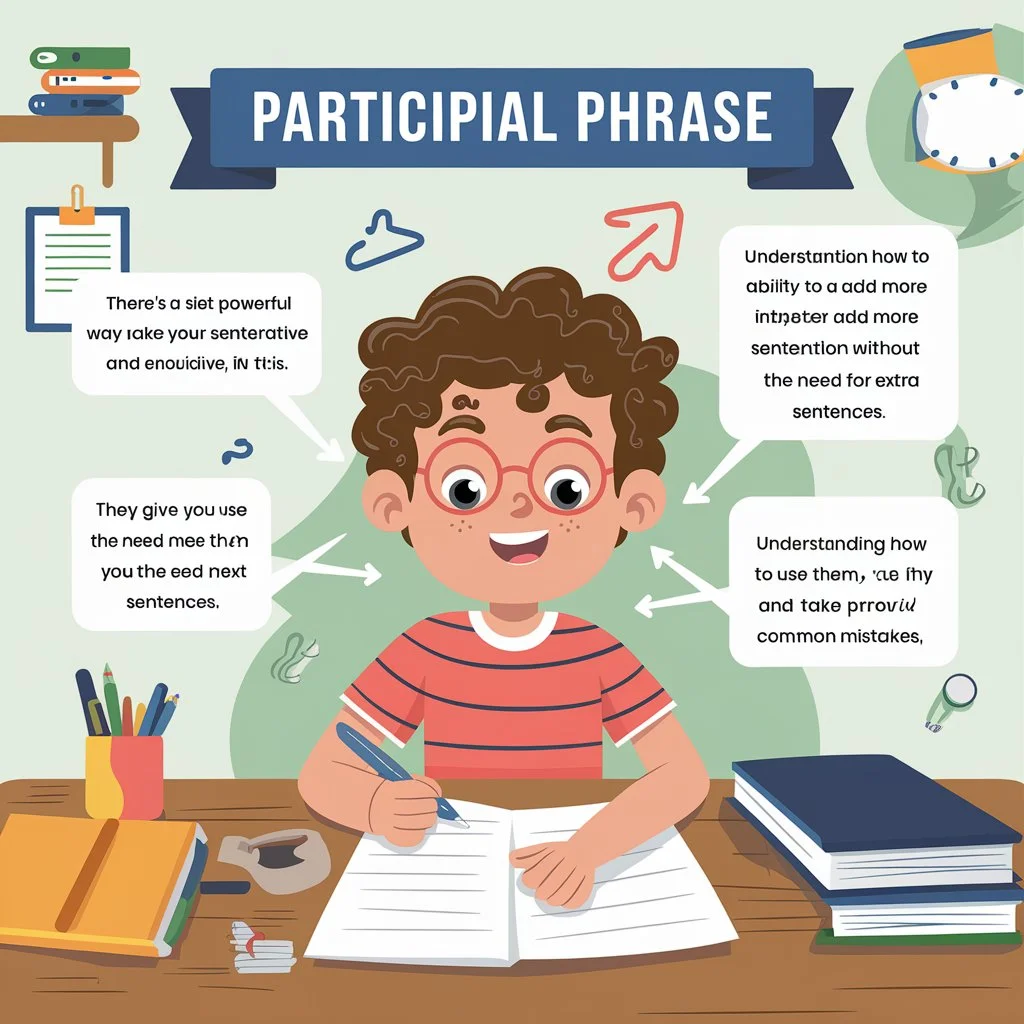Participial phrases are a simple yet powerful way to make your sentences more descriptive and engaging. They give you the ability to add more information without the need for extra sentences. Understanding how to use them can take your writing to the next level. In this post, we’ll break down what participial phrases are, how to use them, and how to avoid common mistakes. We’ll also provide tips to help you master this skill!
What is a Participial Phrase?
A participial phrase is a group of words that begins with a participle and includes any modifiers or objects. It functions as an adjective, meaning it describes or modifies a noun or pronoun in a sentence.
Understanding Participles
The key to understanding participial phrases is knowing what a participle is. A participle is a form of a verb that can function as an adjective. There are two types of participles:
- Present participles: These end in -ing (e.g., running, laughing).
- Past participles: These usually end in -ed, -en, or other irregular endings (e.g., walked, driven, broken).
A participial phrase uses these forms of verbs to describe a noun.
For example, in the sentence:
The man, walking down the street, smiled.
The phrase “walking down the street” is a participial phrase that describes the man.
How Participial Phrases Work
Participial phrases describe nouns or pronouns in a sentence, adding extra details. They act like adjectives, but instead of just a word, they give you a whole phrase. The present participle or past participle starts the phrase, followed by any other words that help describe the action.
Here’s another example:
Hoping for a good grade, Sarah studied hard.
In this sentence, “Hoping for a good grade” is the participial phrase. It tells us more about Sarah by describing what she is doing while she studies.
Structure of Participial Phrases
Now that you understand what a participial phrase is, let’s look at the basic structure.
Components of a Participial Phrase
A participial phrase generally consists of:
- A participle (either present or past participle)
- Any modifiers or objects that give more detail to the action
These phrases typically come before or after the noun they modify. They give important details that make the sentence clearer or more interesting.
Examples of Participial Phrases in Action
Here are a few examples to show you how they work:
- The cat, purring loudly, curled up on the couch.
- “Purring loudly” is the participial phrase that describes the cat.
- Broken by the fall, the vase lay shattered on the floor.
- “Broken by the fall” describes the vase.
- Running through the rain, she reached her car just in time.
- “Running through the rain” tells us more about the action of she reaching the car.
In these examples, you can see how the participial phrase adds more details to the noun. It paints a clearer picture for the reader.
How to Use Participial Phrases in Writing
Participial phrases can add depth to your writing, making your sentences more dynamic and varied. But how exactly should you use them?
Using Participial Phrases to Describe Nouns
One of the best ways to use participial phrases is to describe a noun or pronoun in your sentence. They work well to provide extra information in a single sentence without making your writing too wordy.
Example:
The boy, holding a red balloon, smiled brightly.
In this example, the participial phrase “holding a red balloon” tells us more about the boy and what he’s doing.
Starting a Sentence with a Participial Phrase
Another great use for participial phrases is at the beginning of a sentence. This adds variety to your sentence structure and makes your writing more engaging.
Example:
Shivering in the cold, Mark zipped up his jacket.
The participial phrase “Shivering in the cold” sets the scene and makes the sentence more vivid.
Adding Participial Phrases After the Noun
You can also place the participial phrase right after the noun it describes. This makes the sentence flow smoothly and ensures the description is immediately connected to the noun.
Example:
The cake, baked to perfection, was ready to serve.
Here, “baked to perfection” adds a clear description of the cake, letting the reader know how it was made.
Creating Sentence Variety
Using participial phrases is an easy way to add variety to your sentence structure. Instead of using the same sentence format over and over again, participial phrases let you shake things up.
Example:
The wind, howling through the trees, rattled the windows.
Instead of a basic sentence like “The wind rattled the windows,” this sentence uses a participial phrase to make it more interesting and descriptive.
Common Mistakes with Participial Phrases
While participial phrases are helpful, they can also cause problems if not used correctly. Let’s look at some common mistakes and how to avoid them.
Dangling Participles
A dangling participle occurs when the participial phrase doesn’t clearly describe the noun it’s supposed to. This can confuse the reader.
For example:
Running down the street, the wind blew hard.
In this sentence, it sounds like the wind is running down the street, which doesn’t make sense. To fix it, rewrite the sentence so the participial phrase clearly describes the noun:
Running down the street, the boy felt the wind blow hard.
Now it’s clear that the boy is the one running, not the wind.
Misplacing the Participial Phrase
The placement of the participial phrase is important. If it’s too far from the noun it describes, it can make the sentence confusing or awkward.
For example:
She grabbed her keys, hearing the alarm, and ran to the door.
This sentence feels clunky because the participial phrase “hearing the alarm” is separated from the noun it describes (she). A better version would be:
Hearing the alarm, she grabbed her keys and ran to the door.
This revision places the participial phrase right where it should be, making the sentence smoother.
Overusing Participial Phrases
While participial phrases are useful, it’s important not to overuse them. Too many participial phrases can make your writing feel repetitive and unnatural. Use them sparingly to enhance your writing, but mix them with other sentence structures for balance.
Tips for Mastering Participial Phrases
If you want to get better at using participial phrases, there are a few simple tips that can help you improve.
Practice Identifying Participial Phrases
Start by practicing how to identify participial phrases in the sentences you read. Look for verbs ending in -ing or -ed, and see how they describe nouns. The more you spot them, the easier it will be to use them in your own writing.
Write Sentences with Participial Phrases
One of the best ways to master participial phrases is to write your own sentences using them. Try adding them to your paragraphs to make your writing more descriptive. Here’s a simple practice exercise:
- Take a basic sentence, like “The dog barked.”
- Add a participial phrase to describe the dog: “Barking loudly, the dog stood at the door.”
Doing this regularly will help you get comfortable using participial phrases in your writing.
Use Worksheets and Exercises
You can also find participial phrase worksheets and practice exercises online. These worksheets provide plenty of opportunities to test your skills and reinforce what you’ve learned.
Participial Phrases vs. Other Modifying Phrases
It’s important to know how participial phrases compare to other types of modifying phrases, such as prepositional phrases, infinitive phrases, and appositive phrases.
Prepositional Phrases
A prepositional phrase starts with a preposition and acts as an adjective or adverb, providing more details. For example:
The cat is on the table.
Here, “on the table” is the prepositional phrase. It describes where the cat is.
Infinitive Phrases
An infinitive phrase begins with the word “to” followed by a verb. It can act as a noun, adjective, or adverb.
Example:
To win the race, she practiced every day.
The phrase “To win the race” is an infinitive phrase that tells us why she practiced.
Appositive Phrases
An appositive phrase renames or identifies a noun or pronoun in a sentence. It provides extra information, often set off by commas.
Example:
My brother, a talented musician, plays the guitar.
The phrase “a talented musician” is an appositive phrase that gives more information about my brother.
Participial phrases are just one of many types of modifiers that can enhance your writing, but they stand out for their ability to make sentences more descriptive and engaging.
FAQs
What is a participial phrase?
A participial phrase is a group of words that starts with a participle (a verb ending in -ing or -ed) and describes a noun. It acts like an adjective to give more details about the noun. For example, in “The dog, wagging its tail, ran home,” the phrase “wagging its tail” is a participial phrase that tells us more about the dog.
How do participial phrases improve writing?
Participial phrases make writing more descriptive and interesting. They help to give extra information about a noun without adding more sentences. This makes sentences more detailed and varied.
What is a dangling participle?
A dangling participle happens when a participial phrase doesn’t clearly match the noun it’s describing. This makes the sentence confusing or awkward. To fix it, always make sure the phrase is next to the noun it’s describing.
Where do participial phrases go in a sentence?
Participial phrases can go at the beginning, middle, or end of a sentence. They usually come right before or after the noun they describe. For example, “Shivering in the cold, she grabbed her coat.”
What is the difference between participial phrases and prepositional phrases?
A participial phrase starts with a participle (-ing or -ed verb) and describes a noun, while a prepositional phrase starts with a preposition (like “on,” “in,” or “under”) and shows direction or location. For example, “Sitting by the fire, the dog slept.” (participial) vs. “The dog is under the table.” (prepositional).
Conclusion
Participial phrases are a fantastic tool to improve your writing by adding more description and variety to your sentences. They help you make your writing clearer, more engaging, and more detailed without overcomplicating things.

I’m Clara Whitmore, the girl running the show at “Grammer Grove.” I’ve been playing with expressions and formats to make grammer a whole lot of fun. Over at Grammer grove, we’re here to make your English grammer incredible. Let’s add some professionalism and gratitude to yourwritting together!












